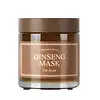What's inside
What's inside
 Key Ingredients
Key Ingredients

 Benefits
Benefits

 Concerns
Concerns

 Ingredients Side-by-side
Ingredients Side-by-side

Glycerin
HumectantPanax Ginseng Root Extract 3.97%
EmollientButylene Glycol
HumectantPanax Ginseng Seed Oil
EmollientGlycyrrhiza Uralensis Root Extract
Skin ConditioningPaeonia Albiflora Root Extract
Skin ConditioningAngelica Gigas Root Extract
Skin ConditioningRheum Palmatum Root Extract
AstringentAngelica Pubescens Root Extract
Skin ConditioningSchizonepeta Tenuifolia Extract
Skin ConditioningPhellodendron Amurense Bark Extract
Skin ConditioningMalt Extract
Skin ProtectingEthoxydiglycol
HumectantHydrolyzed Glycosaminoglycans
HumectantHyaluronic Acid
HumectantBoswellia Serrata Resin Extract
Smoothing1,2-Hexanediol
Skin ConditioningWater
Skin ConditioningEthylhexylglycerin
Skin ConditioningPEG-60 Hydrogenated Castor Oil
EmulsifyingIsohexadecane
EmollientPolysorbate 80
EmulsifyingSodium Acrylate/Sodium Acryloyldimethyl Taurate Copolymer
Emulsion StabilisingGlycerin, Panax Ginseng Root Extract 3.97%, Butylene Glycol, Panax Ginseng Seed Oil, Glycyrrhiza Uralensis Root Extract, Paeonia Albiflora Root Extract, Angelica Gigas Root Extract, Rheum Palmatum Root Extract, Angelica Pubescens Root Extract, Schizonepeta Tenuifolia Extract, Phellodendron Amurense Bark Extract, Malt Extract, Ethoxydiglycol, Hydrolyzed Glycosaminoglycans, Hyaluronic Acid, Boswellia Serrata Resin Extract, 1,2-Hexanediol, Water, Ethylhexylglycerin, PEG-60 Hydrogenated Castor Oil, Isohexadecane, Polysorbate 80, Sodium Acrylate/Sodium Acryloyldimethyl Taurate Copolymer
Water
Skin ConditioningButylene Glycol
HumectantGlycerin
HumectantMethyl Trimethicone
Skin ConditioningCeramide AP
Skin Conditioning1,2-Hexanediol
Skin ConditioningSqualane
EmollientPhenyl Trimethicone
Skin ConditioningPCA Dimethicone
Skin ConditioningCaprylyl Methicone
Skin ConditioningAmmonium Acryloyldimethyltaurate/Vp Copolymer
Lactobacillus Ferment Lysate
Skin ConditioningCarbomer
Emulsion StabilisingPropanediol
SolventTromethamine
BufferingAcrylates/C10-30 Alkyl Acrylate Crosspolymer
Emulsion StabilisingGlyceryl Caprylate
EmollientEthylhexylglycerin
Skin ConditioningDisodium EDTA
Raffinose
Skin ConditioningStearyl Behenate
EmollientMalachite Extract
AntioxidantParfum
MaskingPolyglyceryl-3 Methylglucose Distearate
EmulsifyingInulin Lauryl Carbamate
Emulsion StabilisingNiacinamide
SmoothingTryptophan
MaskingHydroxypropyl Bispalmitamide Mea
EmollientBeta-Glucan
Skin ConditioningLimonene
PerfumingSaururus Chinensis Extract
Skin ConditioningAcorus Gramineus Extract
HumectantLinalool
PerfumingTocopherol
AntioxidantWater, Butylene Glycol, Glycerin, Methyl Trimethicone, Ceramide AP, 1,2-Hexanediol, Squalane, Phenyl Trimethicone, PCA Dimethicone, Caprylyl Methicone, Ammonium Acryloyldimethyltaurate/Vp Copolymer, Lactobacillus Ferment Lysate, Carbomer, Propanediol, Tromethamine, Acrylates/C10-30 Alkyl Acrylate Crosspolymer, Glyceryl Caprylate, Ethylhexylglycerin, Disodium EDTA, Raffinose, Stearyl Behenate, Malachite Extract, Parfum, Polyglyceryl-3 Methylglucose Distearate, Inulin Lauryl Carbamate, Niacinamide, Tryptophan, Hydroxypropyl Bispalmitamide Mea, Beta-Glucan, Limonene, Saururus Chinensis Extract, Acorus Gramineus Extract, Linalool, Tocopherol
 Reviews
Reviews

Ingredients Explained
These ingredients are found in both products.
Ingredients higher up in an ingredient list are typically present in a larger amount.
1,2-Hexanediol is a synthetic liquid and another multi-functional powerhouse.
It is a:
- Humectant, drawing moisture into the skin
- Emollient, helping to soften skin
- Solvent, dispersing and stabilizing formulas
- Preservative booster, enhancing the antimicrobial activity of other preservatives
Butylene Glycol (or BG) is used within cosmetic products for a few different reasons:
Overall, Butylene Glycol is a safe and well-rounded ingredient that works well with other ingredients.
Though this ingredient works well with most skin types, some people with sensitive skin may experience a reaction such as allergic rashes, closed comedones, or itchiness.
Learn more about Butylene GlycolEthylhexylglycerin (we can't pronounce this either) is commonly used as a preservative and skin softener. It is derived from glyceryl.
You might see Ethylhexylglycerin often paired with other preservatives such as phenoxyethanol. Ethylhexylglycerin has been found to increase the effectiveness of these other preservatives.
Glycerin is already naturally found in your skin. It helps moisturize and protect your skin.
A study from 2016 found glycerin to be more effective as a humectant than AHAs and hyaluronic acid.
As a humectant, it helps the skin stay hydrated by pulling moisture to your skin. The low molecular weight of glycerin allows it to pull moisture into the deeper layers of your skin.
Hydrated skin improves your skin barrier; Your skin barrier helps protect against irritants and bacteria.
Glycerin has also been found to have antimicrobial and antiviral properties. Due to these properties, glycerin is often used in wound and burn treatments.
In cosmetics, glycerin is usually derived from plants such as soybean or palm. However, it can also be sourced from animals, such as tallow or animal fat.
This ingredient is organic, colorless, odorless, and non-toxic.
Glycerin is the name for this ingredient in American English. British English uses Glycerol/Glycerine.
Learn more about GlycerinWater. It's the most common cosmetic ingredient of all. You'll usually see it at the top of ingredient lists, meaning that it makes up the largest part of the product.
So why is it so popular? Water most often acts as a solvent - this means that it helps dissolve other ingredients into the formulation.
You'll also recognize water as that liquid we all need to stay alive. If you see this, drink a glass of water. Stay hydrated!
Learn more about Water